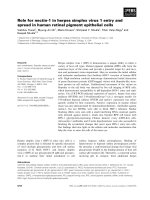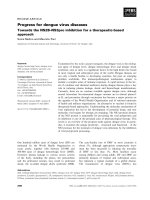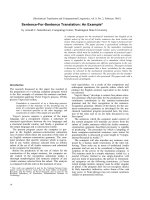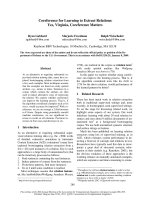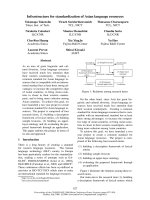Báo cáo khoa học: "Estimators for Stochastic "Unification-Based" Grammars*" docx
Bạn đang xem bản rút gọn của tài liệu. Xem và tải ngay bản đầy đủ của tài liệu tại đây (638.21 KB, 7 trang )
Estimators for Stochastic "Unification-Based" Grammars*
Mark
Johnson
Cognitive and Linguistic Sciences
Brown University
Stuart Geman
Applied Mathematics
Brown University
Stephen
Canon
Cognitive and Linguistic Sciences
Brown University
Zhiyi Chi
Dept. of Statistics
The University of Chicago
Stefan Riezler
Institut fiir Maschinelle Sprachverarbeitung
Universit~t Stuttgart
Abstract
Log-linear models provide a statistically sound
framework for Stochastic "Unification-Based"
Grammars (SUBGs) and stochastic versions of
other kinds of grammars. We describe two
computationally-tractable ways of estimating
the parameters of such grammars from a train-
ing corpus of syntactic analyses, and apply
these to estimate a stochastic version of Lexical-
Functional Grammar.
1 Introduction
Probabilistic methods have revolutionized com-
putational linguistics. They can provide a
systematic treatment of preferences in pars-
ing. Given a suitable estimation procedure,
stochastic models can be "tuned" to reflect the
properties of a corpus. On the other hand,
"Unification-Based" Grammars (UBGs) can ex-
press a variety of linguistically-important syn-
tactic and semantic constraints. However, de-
veloping Stochastic "Unification-based" Gram-
mars (SUBGs) has not proved as straight-
forward as might be hoped.
The simple "relative frequency" estimator
for PCFGs yields the maximum likelihood pa-
rameter estimate, which is to say that it
minimizes the Kulback-Liebler divergence be-
tween the training and estimated distributions.
On the other hand, as Abney (1997) points
out, the context-sensitive dependencies that
"unification-based" constraints introduce ren-
der the relative frequency estimator suboptimal:
in general it does not maximize the likelihood
and it is inconsistent.
* This research was supported by the National Science
Foundation (SBR,-9720368), the US Army Research Of-
fice (DAAH04-96-BAA5), and Office of Naval Research
(N00014-97-1-0249).
Abney (1997) proposes a Markov Random
Field or log linear model for SUBGs, and the
models described here are instances of Abney's
general framework. However, the Monte-Carlo
parameter estimation procedure that Abney
proposes seems to be computationally imprac-
tical for reasonable-sized grammars. Sections 3
and 4 describe two new estimation procedures
which are computationally tractable. Section 5
describes an experiment with a small LFG cor-
pus provided to us by Xerox PAaC. The log
linear framework and the estimation procedures
are extremely general, and they apply directly
to stochastic versions of HPSG and other theo-
ries of grammar.
2 Features in SUBGs
We follow the statistical literature in using the
term
feature
to refer to the properties that pa-
rameters are associated with (we use the word
"attribute" to refer to the attributes or features
of a UBG's feature structure). Let ~ be the
set of all possible grammatical or well-formed
analyses. Each feature f maps a syntactic anal-
ysis w E ~ to a real value
f(w).
The form of
a syntactic analysis depends on the underlying
linguistic theory. For example, for a PCFG w
would be parse tree, for a LFG w would be a
tuple consisting of (at least) a c-structure, an f-
structure and a mapping from c-structure nodes
to f-structure elements, and for a Chomskyian
transformational grammar w would be a deriva-
tion.
Log-linear models are models in which the
log probability is a linear combination of fea-
ture values (plus a constant). PCFGs, Gibbs
distributions, Maximum-Entropy distributions
and Markov Random Fields are all examples of
log-linear models. A log-linear model associates
each feature fj with a real-valued parameter Oj.
535
A log-linear model with m features is one in
which the likelihood P(w) of an analysis w is:
PO(CO) 1
eEj= 1 ojlj(~o)
Zo
Zo Z eZJ=l Ojfj(oJ)
w'E~
While the estimators described below make
no assumptions about the range of the
.fi,
in
the models considered here the value of each
feature fi(w) is the number of times a particu-
lar structural arrangement or configuration oc-
curs in the analysis w, so
fi(w)
ranges over the
natural numbers.
For example, the features of a PCFG are
indexed by productions, i.e., the value
fi(w)
of feature fi is the number of times the
ith production is used in the derivation w.
This set of features induces a tree-structured
dependency graph on the productions which
is characteristic of Markov Branching Pro-
cesses (Pearl, 1988; Frey, 1998). This tree
structure has the important consequence that
simple "relative-frequencies" yield maximum-
likelihood estimates for the
Oi.
Extending a PCFG model by adding addi-
tional features not associated with productions
will in general add additional dependencies, de-
stroy the tree structure, and substantially com-
plicate maximum likelihood estimation.
This is the situation for a SUBG, even if the
features are production occurences. The uni-
fication constraints create non-local dependen-
cies among the productions and the dependency
graph of a SUBG is usually not a tree. Conse-
quently, maximum likelihood estimation is no
longer a simple matter of computing relative
frequencies. But the resulting estimation proce-
dures (discussed in detail, shortly), albeit more
complicated, have the virtue of applying to es-
sentially arbitrary features of the production
or non-production type. That is, since estima-
tors capable of finding maximum-likelihood pa-
rameter estimates for production features in a
SUBG will also find maximum-likelihood esti-
mates for non-production features, there is no
motivation for restricting features to be of the
production type.
Linguistically there is no particular reason
for assuming that productions are the best fea-
tures to use in a stochastic language model.
For example, the adjunct attachment ambigu-
ity in (1) results in alternative syntactic struc-
tures which use the same productions the same
number of times in each derivation, so a model
with only production features would necessarily
assign them the same likelihood. Thus models
that use production features alone predict that
there should not be a systematic preference for
one of these analyses over the other, contrary to
standard psycholinguistic results.
1.a Bill thought Hillary [vp[vP left ] yesterday ]
1.b Bill [vP[vP thought Hillary left ] yesterday ]
There are many different ways of choosing
features for a SUBG, and each of these choices
makes an empirical claim about possible distri-
butions of sentences. Specifying the features of
a SUBG is as much an empirical matter as spec-
ifying the grammar itself. For any given UBG
there are a large (usually infinite) number of
SUBGs that can be constructed from it, differ-
ing only in the features that each SUBG uses.
In addition to production features, the
stochastic LFG models evaluated below used
the following kinds of features, guided by the
principles proposed by Hobbs and Bear (1995).
Adjunct and argument features indicate adjunct
and argument attachment respectively, and per-
mit the model to capture a general argument
attachment preference. In addition, there are
specialized adjunct and argument features cor-
responding to each grammatical function used
in LFG (e.g., SUB J, OBJ, COMP, XCOMP,
ADJUNCT, etc.). There are features indi-
cating both high and low attachment (deter-
mined by the complexity of the phrase being
attached to). Another feature indicates non-
right-branching nonterminal nodes. There is
a feature for non-parallel coordinate structures
(where parallelism is measured in constituent
structure terms). Each f-structure attribute-
atomic value pair which appears in any feature
structure is also used as a feature. We also use
a number of features identifying syntactic struc-
tures that seem particularly important in these
corpora, such as a feature identifying NPs that
are dates (it seems that date interpretations of
NPs are preferred). We would have liked to
have included features concerning specific lex-
ical items (to capture head-to-head dependen-
cies), but we felt that our corpora were so small
536
that the associated parameters could not be ac-
curately estimated.
3 A pseudo-likelihood estimator for
log linear models
Suppose ~ = Wl, ,Wn is a training cor-
pus of n syntactic analyses. Letting
fj(~) =
~i=l, ,n fJ (wi), the log likelihood of the corpus
and its derivatives are:
logL0(~) = ~
Ojfj(~)-nlogZo(2)
j=l, ,m
0 log L0 (~)
- - nEd/j) (3)
ooj
where
Eo(fj)
is the expected value of fj under
the distribution determined by the parameters
0. The maximum-likelihood estimates are the 0
which maximize log Lo(~). The chief difficulty
in finding the maximum-likelihood estimates is
calculating E0
(fj),
which involves summing over
the space of well-formed syntactic structures ft.
There seems to be no analytic or efficient nu-
merical way of doing this for a realistic SUBG.
Abney (1997) proposes a gradient ascent,
based upon a Monte Carlo procedure for esti-
mating E0(fj). The idea is to generate random
samples of feature structures from the distribu-
tion P~i(w), where 0 is the current parameter
estimate, and to use these to estimate E~(fj),
and hence the gradient of the likelihood. Sam-
ples are generated as follows: Given a SUBG,
Abney constructs a covering PCFG based upon
the SUBG and 0, the current estimate of 0. The
derivation trees of the PCFG can be mapped
onto a set containing all of the SUBG's syn-
tactic analyses. Monte Carlo samples from the
PCFG are comparatively easy to generate, and
sample syntactic analyses that do not map to
well-formed SUBG syntactic structures are then
simply discarded. This generates a stream of
syntactic structures, but not distributed accord-
ing to P~(w) (distributed instead according to
the restriction of the PCFG to the SUBG). Ab-
ney proposes using a Metropolis acceptance-
rejection method to adjust the distribution of
this stream of feature structures to achieve de-
tailed balance, which then produces a stream
of feature structures distributed according to
Po(w).
While this scheme is theoretically sound, it
would appear to be computationally impracti-
cal for realistic SUBGs. Every step of the pro-
posed procedure (corresponding to a single step
of gradient ascent) requires a very large number
of PCFG samples: samples must be found that
correspond to well-formed SUBGs; many such
samples are required to bring the Metropolis al-
gorithm to (near) equilibrium; many samples
are needed at equilibrium to properly estimate
E0(Ij).
The idea of a gradient ascent of the likelihood
(2) is appealing a simple calculation reveals
that the likelihood is concave and therefore free
of local maxima. But the gradient (in partic-
ular, Ee(fj)) is intractable. This motivates an
alternative strategy involving a data-based esti-
mate of E0(fj):
Ee(fj) =
Ee(Ee(fj(w)ly(w)))
(4)
1
= - ~ Ea(fj(w)ly(w) =yd(5)
72 i=l, ,n
where
y(w)
is the yield belonging to the syn-
tactic analysis w, and
Yi = y(wi)
is the yield
belonging to the i'th sample in the training cor-
pus.
The point is that
Ee(fj(w)ly(w ) = Yi)
is gen-
erally computable. In fact, if f~(y) is the set of
well-formed syntactic structures that have yield
y (i.e., the set of possible parses of the string y),
then
Eo(fj( o)ly( ,) = =
Ew'Ef~(yi)
f J(w') e~-~k=x Ok$1,(w')
Hence the calculation of the conditional expec-
tations only involves summing over the possible
syntactic analyses or parses
f~(Yi)
of the strings
in the training corpus. While it is possible to
construct UBGs for which the number of pos-
sible parses is unmanageably high, for many
grammars it is quite manageable to enumerate
the set of possible parses and thereby directly
evaluate
Eo(f j(w)ly(w ) = Yi).
Therefore, we propose replacing the gradient,
(3), by
fj(w)
- ~
Eo(fj(w)lY(W) = Yi)
(6)
i=l, ,n
and performing a gradient ascent. Of course (6)
is no longer the gradient of the likelihood func-
537
tion, but fortunately it is (exactly) the gradient
of (the log of) another criterion:
PLo(~)
= II Po(w = wily(w) = yi)
(7)
i=l, ,n
Instead of maximizing the likelihood of the syn-
tactic analyses over the training corpus, we
maximize the
conditional
likelihood of these
analyses
given the observed yields.
In our exper-
iments, we have used a conjugate-gradient op-
timization program adapted from the one pre-
sented in Press et al. (1992).
Regardless of the pragmatic (computational)
motivation, one could perhaps argue that the
conditional probabilities
Po(wly )
are as use-
ful (if not more useful) as the full probabili-
ties P0(w), at least in those cases for which
the ultimate goal is syntactic analysis. Berger
et al. (1996) and Jelinek (1997) make this same
point and arrive at the same estimator, albeit
through a maximum entropy argument.
The problem of estimating parameters for
log-linear models is not new. It is especially dif-
ficult in cases, such as ours, where a large sam-
ple space makes the direct computation of ex-
pectations infeasible. Many applications in spa-
tial statistics, involving Markov random fields
(MRF), are of this nature as well. In his
seminal development of the MRF approach to
spatial statistics, Besag introduced a "pseudo-
likelihood" estimator to address these difficul-
ties (Besag, 1974; Besag, 1975), and in fact our
proposal here is an instance of his method. In
general, the likelihood function is replaced by a
more manageable product of conditional likeli-
hoods (a
pseudo-likelihood hence
the designa-
tion PL0), which is then optimized over the pa-
rameter vector, instead of the likelihood itself.
In many cases, as in our case here, this sub-
stitution side steps much of the computational
burden
without sacrificing consistency
(more on
this shortly).
What are the asymptotics of optimizing a
pseudo-likelihood function? Look first at the
likelihood itself. For large n:
1 logL0(~) 1 log II
Po(wi)
n n
i=l, ,n
1 ~ logp0(w d
F& i=l, ,n
f Poo(w)logPo(w)dw
(8)
where 0o is the true (and unknown) parame-
ter vector. Up to a constant, (8) is the nega-
tive of the Kullback-Leibler divergence between
the true and estimated distributions of syntac-
tic analyses. As sample size grows, maximizing
likelihood amofints to minimizing divergence.
As for pseudo-likelihood:
1
- log PL0(~)
n
l l°g IX
Po(w wi{y(w)=yi)
n
i=l, ,n
_ _1 ~ logPo(w=wily(
w )=Yi)
n i=l, ,n
EOo [f P0o
(wly)
log P0
(wly)dw]
So that maximizing pseudo-likelihood (at large
samples) amounts to minimizing the average
(over yields) divergence between the true and
estimated
conditional distributions of analyses
given yields.
Maximum likelihood estimation is consistent:
under broad conditions the sequence of dis-
tributions P0 , associated with the maximum
r~
likelihood estimator for 0o given the samples
Wl, wn,
converges to P0o. Pseudo-likelihood
is also consistent, but in the present implemen-
tation it is consistent for the conditional dis-
tributions P0o
(w[y(w))
and not necessarily for
the full distribution P0o (see Chi (1998)). It is
not hard to see that pseudo-likelihood will not
always correctly estimate P0o- Suppose there
is a feature
fi
which depends only on yields:
fi(w) = fi(y(w)).
(Later we will refer to such
features as
pseudo-constant.)
In this case, the
derivative of PL0 (~) with respect to
Oi
is zero;
PL0(~) contains no information about
Oi.
In
fact, in this case
any
value of
Oi
gives the
same
conditional distribution
Po(wly(w)); Oi
is irrele-
vant to the problem of choosing good parses.
Despite the assurance of consistency, pseudo-
likelihood estimation is prone to over fitting
when a large number of features is matched
against a modest-sized training corpus. One
particularly troublesome manifestation of over
fitting results from the existence of features
which, relative to the training set, we might
term "pseudo-maximal": Let us say that a
feature f is
pseudo-maximal
for a yield y iff
538
Vw' E ~)(y)f(w) ~ f(J) where w is any cor-
rect parse of y, i.e., the feature's value on every
correct parse w of y is greater than or equal
to its value on any other parse of y. Pseudo-
minimal features are defined similarly. It is easy
to see that if fj is pseudo-maximal on
each sen-
tence
of the training corpus then the param-
eter assignment
Oj = co
maximizes the cor-
pus pseudo-likelihood. (Similarly, the assign-
ment
Oj = -oo
maximizes pseudo-likelihood if
fj
is pseudo-minimal over the training corpus).
Such infinite parameter values indicate that the
model treats pseudo-maximal features categori-
cally; i.e., any parse with a non-maximal feature
value is assigned a zero conditional probability.
Of course, a feature which is pseudo-maximal
over the training corpus is not necessarily
pseudo-maximal for all yields. This is an in-
stance of over fitting, and it can be addressed,
as is customary, by adding a regularization term
that promotes small values of 0 to the objec-
tive function. A common choice is to add a
quadratic to the log-likelihood, which corre-
sponds to multiplying the likelihood itself by
a normal distribution. In our experiments, we
multiplied the pseudo-likelihood by a zero-mean
normal in 01,
Om,
with diagonal covariance,
and with standard deviation
aj
for 0j equal to
7 times the maximum value of fj found in any
parse in the training corpus. (We experimented
with other values for aj, but the choice seems to
have little effect). Thus instead of maximizing
the log pseudo-likelihood, we choose 0 to maxi-
mize
/3z 2
log PL0(~) - ~ 2avJ2 (9)
j=l, ,m
J
4 A maximum correct estimator for
log linear models
The pseudo-likelihood estimator described in
the last section finds parameter values which
maximize the conditional probabilities of the
observed parses (syntactic analyses) given the
observed sentences (yields) in the training cor-
pus. One of the empirical evaluation measures
we use in the next section measures the num-
ber of correct parses selected from the set of
all possible parses. This suggests another pos-
sible objective function: choose ~ to maximize
the number
Co
(~) of times the maximum likeli-
hood parse (under 0) is in fact the correct parse,
in the training corpus.
Co(~)
is a highly discontinuous function of 0,
and most conventional optimization algorithms
perform poorly on it. We had the most suc-
cess with a slightly modified version of the sim-
ulated annealing optimizer described in Press
et al. (1992). This procedure is much more com-
putationally intensive than the gradient-based
pseudo-likelihood procedure. Its computational
difficulty grows (and the quality of solutions de-
grade) rapidly with the number of features.
5 Empirical evaluation
Ron Kaplan and Hadar Shemtov at Xerox PArtC
provided us with two LFG parsed corpora. The
Verbmobil corpus contains appointment plan-
ning dialogs, while the Homecentre corpus is
drawn from Xerox printer documentation. Ta-
ble 1 summarizes the basic properties of these
corpora. These corpora contain packed c/f-
structure representations (Maxwell III and Ka-
plan, 1995) of the grammatical parses of each
sentence with respect to Lexical-Functional
grammars. The corpora also indicate which of
these parses is in fact the correct parse (this
information was manually entered). Because
slightly different grammars were used for each
corpus we chose not to combine the two corpora,
although we used the set of features described in
section 2 for both in the experiments described
below. Table 2 describes the properties of the
features used for each corpus.
In addition to the two estimators described
above we also present results from a baseline es-
timator in which all parses are treated as equally
likely (this corresponds to setting all the param-
eters
Oj
to zero).
We evaluated our estimators using held-out
test corpus
~test.
We used two evaluation
measures. In an actual parsing application a
SUBG might be used to identify the correct
parse from the set of grammatical parses, so
our first evaluation measure counts the number
Co(~test) of sentences in the test corpus
~test
whose maximum likelihood parse under the es-
timated model 0 is actually the correct parse.
If a sentence has 1 most likely parses (i.e., all
1 parses have the same conditional probability)
and one of these parses is the correct parse, then
we score
1/l
for this sentence.
The second evaluation measure is the pseudo-
539
Number of sentences
Number of ambiguous sentences
Number of parses of ambiguous sentences
Verbmobil corpus Homecentre corpus
540 980
314 481
3245 3169
Table 1: Properties of the two corpora used to evaluate the estimators.
Verbmobil corpus Homecentre corpus
Number of features 191 227
Number of rule features 59 57
Number of pseudo-constant features 19 41
Number of pseudo-maximal features 12 4
Number of pseudo-minimal features 8 5
Table 2: Properties of the features used in the stochastic LFG models. The numbers of pseudo-
maximal and pseudo-minimal features do not include pseudo-constant features.
likelihood itself,
PL~(wtest).
The pseudo-
likelihood of the test corpus is the likelihood of
the correct parses given their yields, so pseudo-
likelihood measures how much of the probabil-
ity mass the model puts onto the correct anal-
yses. This metric seems more relevant to ap-
plications where the system needs to estimate
how likely it is that the correct analysis lies in
a certain set of possible parses; e.g., ambiguity-
preserving translation and human-assisted dis-
ambiguation. To make the numbers more man-
ageable, we actually present the negative loga-
rithm of the pseudo-likelihood rather than the
pseudo-likelihood itself so smaller is better.
Because of the small size of our corpora we
evaluated our estimators using a 10-way cross-
validation paradigm. We randomly assigned
sentences of each corpus into 10 approximately
equal-sized subcorpora, each of which was used
in turn as the test corpus. We evaluated on each
subcorpus the parameters that were estimated
from the 9 remaining subcorpora that served as
the training corpus for this run. The evalua-
tion scores from each subcorpus were summed
in order to provide the scores presented here.
Table 3 presents the results of the empiri-
cal evaluation. The superior performance of
both estimators on the Verbmobil corpus prob-
ably reflects the fact that the non-rule fea-
tures were designed to match both the gram-
mar and content of that corpus. The pseudo-
likelihood estimator performed better than the
correct-parses estimator on both corpora un-
der both evaluation metrics. There seems to
be substantial over learning in all these mod-
els; we routinely improved performance by dis-
carding features. With a small number of
features the correct-parses estimator typically
scores better than the pseudo-likelihood estima-
tor on the correct-parses evaluation metric, but
the pseudo-likelihood estimator always scores
better on the pseudo-likelihood evaluation met-
ric.
6
Conclusion
This paper described a log-linear model for
SUBGs and evaluated two estimators for such
models. Because estimators that can estimate
rule features for SUBGs can also estimate other
kinds of features, there is no particular reason to
limit attention to rule features in a SUBG. In-
deed, the number and choice of features strongly
influences the performance of the model. The
estimated models are able to identify the cor-
rect parse from the set of all possible parses ap-
proximately 50% of the time.
We would have liked to introduce features
corresponding to dependencies between lexical
items. Log-linear models are well-suited for lex-
ical dependencies, but because of the large num-
ber of such dependencies substantially larger
corpora will probably be needed to estimate
such models. 1
1Alternatively, it may be possible to use a simpler
non-SUBG model of lexical dependencies estimated from
a much larger corpus as the reference distribution with
540
Baseline estimator
Pseudo-likelihood estimator
Correct-parses estimator
Verbmobil corpus Homecentre corpus
C(~test)
-logPL(~test)
C(~test) -logPL(~test)
9.7% 533 15.2% 655
58.7% 396 58.8% 583
53.7% 469 53.2% 604
Table 3: An empirical evaluation of the estimators.
C(~test)
is the number of maximum likelihood
parses of the test corpus that were the correct parses, and -log
PL(wtest)
is the negative logarithm
of the pseudo-likelihood of the test corpus.
However, there may be applications which
can benefit from a model that performs even at
this level. For example, in a machine-assisted
translation system a model like ours could
be used to order possible translations so that
more likely alternatives are presented before less
likely ones. In the ambiguity-preserving trans-
lation framework, a model like this one could be
used to choose between sets of analyses whose
ambiguities cannot be preserved in translation.
References
Steven P. Abney. 1997. Stochastic Attribute-
Value Grammars.
Computational Linguis-
tics,
23(4):597-617.
Adam~L. Berger, Vincent J. Della Pietra,
and Stephen A. Della Pietra. 1996. A
maximum entropy approach to natural lan-
guage processing.
Computational Linguistics,
22(1):39-71.
J. Besag. 1974. Spatial interaction and the sta-
tistical analysis of lattice systems (with dis-
cussion).
Journal of the Royal Statistical So-
ciety, Series D,
36:192-236.
J. Besag. 1975. Statistical analysis of non-
lattice data.
The Statistician,
24:179-195.
Zhiyi Chi. 1998.
Probability Models for Com-
plex Systems.
Ph.D. thesis, Brown University.
Brendan J. Frey. 1998.
Graphical Models for
Machine Learning and Digital Communica-
tion.
The MIT Press, Cambridge, Mas-
sachusetts.
Jerry R. Hobbs and John Bear. 1995. Two
principles of parse preference. In Antonio
Zampolli, Nicoletta Calzolari, and Martha
Palmer, editors,
Linguistica Computazionale:
Current Issues in Computational Linguistics:
In Honour of Don Walker,
pages 503-512.
Kluwer.
Frederick Jelinek. 1997.
Statistical Methods for
Speech Recognition.
The MIT Press, Cam-
bridge, Massachusetts.
John T. Maxwell III and Ronald M. Kaplan.
1995. A method for disjunctive constraint
satisfaction. In Mary Dalrymple, Ronald M.
Kaplan, John T. Maxwell III, and Annie
Zaenen, editors,
Formal Issues in Lexical-
Functional Grammar,
number 47 in CSLI
Lecture Notes Series, chapter 14, pages 381-
481. CSLI Publications.
Judea Pearl. 1988.
Probabalistic Reasoning in
Intelligent Systems: Networks of Plausible
Inference.
Morgan Kaufmann, San Mateo,
California.
William H. Press, Saul A. Teukolsky,
William T. Vetterling, and Brian P. Flannery.
1992.
Numerical Recipies in C: The Art of
Scientific Computing.
Cambridge University
Press, Cambridge, England, 2nd edition.
respect to which the SUBG model is defined, as described
in Jelinek (1997).
541

